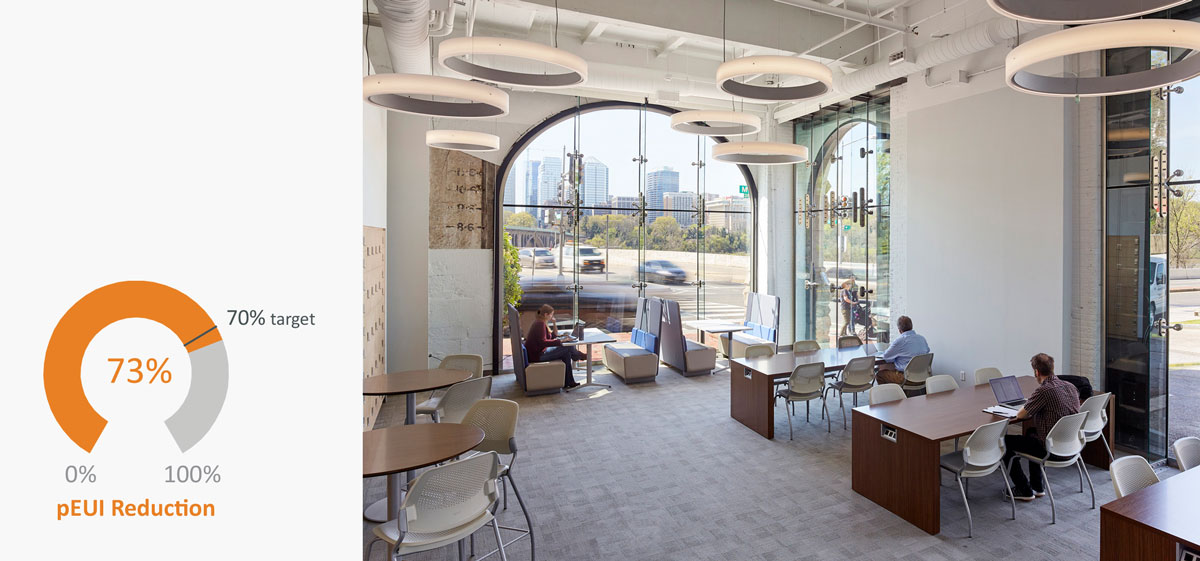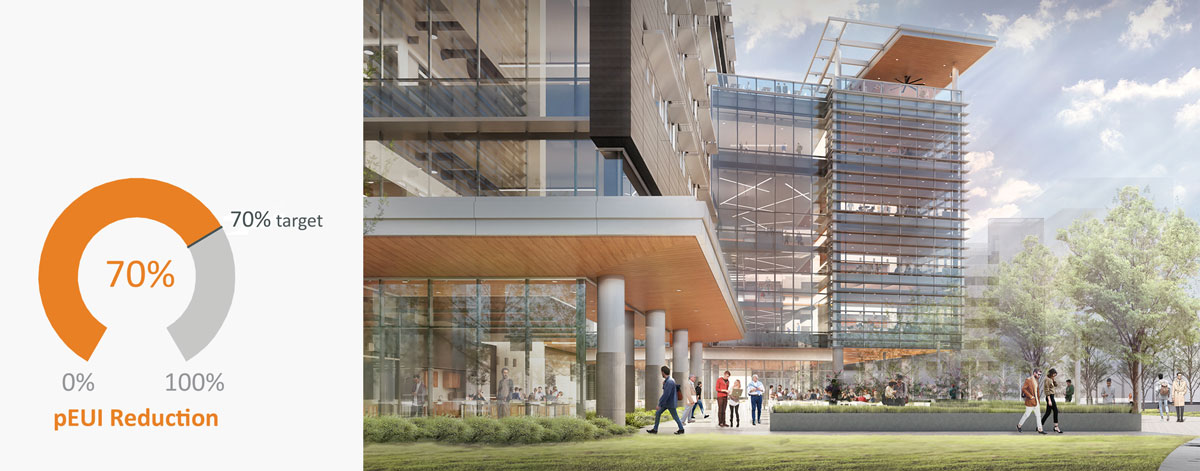Combating Greenhouse Gas Emissions through Building Design

In 2018, and every year since then, University of Reading climate scientist Ed Hawkins has published graphics constituting a chronologically ordered series of colored vertical stripes from 1850 to today, that he called “warming stripes."
The urban built environment causes 75% of annual global greenhouse gas emissions. Buildings alone account for nearly 40% through building materials and construction and building operations, and embodied carbon will contribute 50% of total new construction emissions between now and 2050.
w
These striking and concerning figures are among the main drivers behind efforts such as the AIA 2030 Challenge and the 2030 Challenge for Embodied Carbon, which call on firms in the AEC industry to design net zero buildings and reduce embodied carbon in our projects. The planet is already seeing the deadly effects of climate change in rising seas, increased frequency and intensity of storms, wildfires, and extreme weather events of all kinds. Lowering greenhouse gas emissions is the most substantial way to minimize human impact on climate change and sea level rise. As architects and engineers, we have the responsibility and the opportunity to do our part through our design solutions.
High performance design can be achieved through maximizing efficiency in building space, using low carbon construction, integrating efficient heating, cooling, and lighting systems, and prioritizing energy efficient renovations, among other methods. In practice, this effort is informed by energy modeling and stringent selection of materials and systems.
Historic Car Barn Adaptive Reuse at Georgetown University Highlights Green Renovation
Achieving 73% reduction in pEUI (predicted energy use intensity) compared to the baseline, the Car Barn Adaptive Reuse stands out as an example of how preservation can reduce operational carbon emissions and dramatically reduce embodied carbon by reusing an existing structure. Technology in the form of sensors and controls continues to be a significant factor in reducing energy consumption and emissions:
- Occupancy and daylight sensors control interior lighting in the Car Barn to ensure adequate light while minimizing electricity usage
- An energy efficient HVAC system utilizes variable speed technology on hydronic pumps and air-handling unit motors to properly match the building energy use to the building load
- Improvements to the thermal envelope maximize energy efficiency with the addition of an air barrier and thermal insulation
 Energy Modeling Informs Efficient Headquarters Design
Energy Modeling Informs Efficient Headquarters Design
Ferguson’s new Headquarters 3, nearing construction completion, has a pEUI reduction of 70% compared to the baseline. Energy modeling early in the design process informed key aspects of the design to achieve a substantial reduction in energy consumption and future emissions. This facility is a good example of how a holistic effort that addresses footprint, materials, and systems can deliver impactful results:
- A fairly narrow footprint in the optimum building orientation maximizes daylighting and views while working to reduce solar heat gain
- Open office concept reduces material use on the interior
- Exterior glass was specified with a low solar heat gain coefficient
- The efficient HVAC system integrates multiple features that reduce energy demand:
- A thermal storage system shifts electrical demand for cooling from peak daytime hours to off-peak nighttime hours. The building chillers run at night to produce ice, which is melted during the day while the chillers remain off. As the single largest electrical load in the facility, shifting the operation of the chillers to off-peak hours reduces demand on the public electrical grid and decreases the overall cost of power generation.
- An energy recovery ventilator transfers heat between the exhaust and outdoor air streams using a total enthalpy recovery wheel. During the heating season, heat and moisture is extracted from the exhaust air and transferred to the outdoor air, reducing heating and humidification loads. During the cooling season, heat and moisture is extracted from the outdoor air and transferred to the exhaust air, reducing cooling and dehumidification loads.
- Both the heating and cooling systems are high efficiency and with a high degree of controllability, allowing the systems to meet demand with very little waste.
- The air distribution systems in the building are all variable volume, which again, allows for an exact meeting of comfort demands.
 These case studies highlight how facility design can reduce carbon impacts in both new construction and renovation, but they are only the beginning. The timing is critical to find more sustainable solutions and deploy them widely. While governments have slowly introduced climate change policies, global emissions in 2019 hit 37 billion tons of carbon dioxide (CO2), setting a new record. This means emissions have grown by 62% since international climate negotiations began in 1990 to address the problem. The built environment and the world’s growing population are significant factors, as more people translates to more buildings, cars, infrastructure, and demand for fossil fuels.
These case studies highlight how facility design can reduce carbon impacts in both new construction and renovation, but they are only the beginning. The timing is critical to find more sustainable solutions and deploy them widely. While governments have slowly introduced climate change policies, global emissions in 2019 hit 37 billion tons of carbon dioxide (CO2), setting a new record. This means emissions have grown by 62% since international climate negotiations began in 1990 to address the problem. The built environment and the world’s growing population are significant factors, as more people translates to more buildings, cars, infrastructure, and demand for fossil fuels.
The answers aren’t necessarily easy. They require us to alter our own lifestyles and to challenge the companies we work for and patronize to make meaningful changes. There is some good news — coal use is down dramatically in the United States and European Union, and renewable energy is growing. Those are some of the trends we need to focus on as we move forward.

X
Chris Stone, PE, F.NSPE, F.ASCE, LEED AP is a senior principal at Clark Nexsen with more than 40 years of experience in design and management. He is passionate about the topic of sustainability and resilient design, with a focus on resilient infrastructure and its impact on the urban setting. To connect with Chris, please email cstone@clarknexsen.com.
X
X
